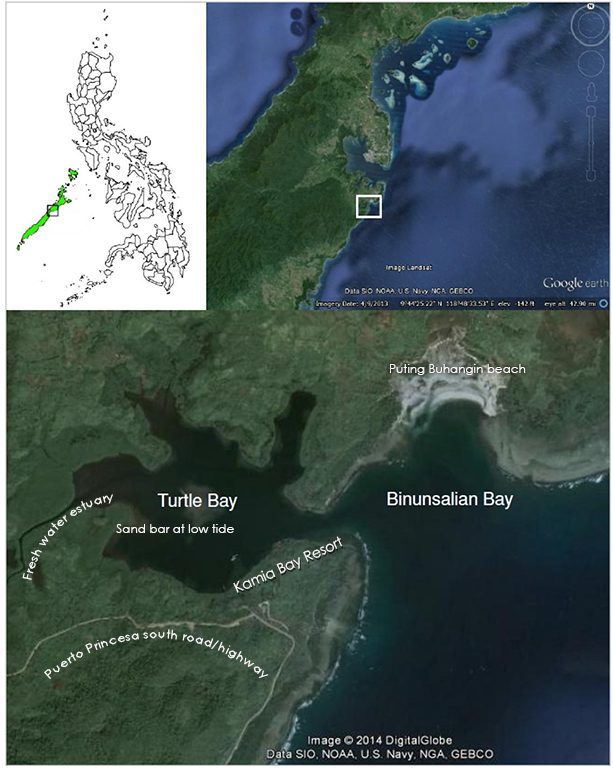This is one of the reasons that the 108 varieties of clams and shells in both bays do so well. Two being environmental indicator species.
"The finding of the rare species Timoclea imbricata (Veneridae) in Turtle Bay, and Vexillum vibex and Scabricola alabaster (Mitridae) in Binunsalian Bay implies the presence of unique niches in both bays and the potential use of these species as ecological indicators."
"Such continued discovery is suggesting that many species are yet unknown to science. The number of species in the current list is expected to increase with continued exploration and documentation of gastropods and bivalves in both bays. The combined number of species (108 species) from Turtle and Binunsalian Bays were higher than those recorded from the mangrove and estuarine (65 species) areas of Iwahig River."
"This justifies the need to strengthen/revise the conservation schemes employed following the declaration of both bays as marine sanctuary more than two decades ago."
And yet even though Seven Seas assisted in this report they want to put in a marina for yachts and boats. There is no question that the proposed "World Class Marina" for yachts and other motorized vehicles will pollute and sink into the mud. This will affect the lives of the bivalves and gastropods (clams and shells) and well as the chain of wild life depending on them for food, such as the population of Asian small clawed otters.
The molluscan fauna (gastropods and bivalves) and notes on environmental conditions of two adjoining protected bays in Puerto Princesa City, Palawan, Philippines - Binusalian and Turtle Bay
The full PDF report is at this link: http://www.entomoljournal.com/vol2Issue5/pdf/34.1.pdf
Below is an excerpt from that journal. Study was submitted by:
"There was a reconnaissance survey on 23 June 2014 to have a clear picture of each site in terms of habitat and presence of gastropods and bivalves. Examined areas during the reconnaissance period were limited to shallow habitats with corals and seaweeds. Between 27 June – 1 July 2014, night sampling activities at different sites were conducted by dredging at sandy-rubble and muddy habitats. During sampling, a fish finder was used to avoid dredging over coral reefs and sea grass beds which can both damage the dredge and the reef ecosystems.'
Rafael M. Picardal-College of Fisheries and Aquatic-Sciences, Western Philippines-University -
Roger G. Dolorosa-College of Fisheries and Aquatic-Sciences, Western Philippines University- email: rogerdolorosa@yahoo.com
"There was a reconnaissance survey on 23 June 2014 to have a clear picture of each site in terms of habitat and presence of gastropods and bivalves. Examined areas during the reconnaissance period were limited to shallow habitats with corals and seaweeds. Between 27 June – 1 July 2014, night sampling activities at different sites were conducted by dredging at sandy-rubble and muddy habitats. During sampling, a fish finder was used to avoid dredging over coral reefs and sea grass beds which can both damage the dredge and the reef ecosystems.'
Ecologically, the importance of molluscs cannot be underestimated. Grazing gastropods can control ephiphytic and macro algal bloom. Under laboratory condition, 20,000 juveniles of hatchery produced gastropod Tectus (Trochus) niloticus of 4 – 7 mm in diameter can consume sessile diatoms covering an area of 6.5 m2 within a week.
Bivalves as filter feeders can help purify silted marine waters. Although molluscs are of huge importance to the ecosystem and the society, not much is known about the gastropods and bivalves of Turtle and Binunsalian Bays in Puerto Princesa City, Province of Palawan, the Philippines. Both bays were declared as marine sanctuaries by the City Government of Puerto Princesa in 1992, but uncontrolled fishing activities could have heavily impacted its molluscan fauna, a similar case for many paper marine sanctuaries in the country
Both bays are the proposed sites of a world class resort that any disturbance during the construction stage and operational phase may have a long term effect on the composition and abundance of these species. This study which sought to document the species richness of molluscs (gastropods and bivalves) and provide notes on ecological conditions of Turtle and Binunsalian Bays may serve as basis in proposing relevant conservation measures and could be used as baseline in monitoring the impacts of any management interventions."
TO SEE ALL THE PHOTOS IN THE REPORT CLICK LINK:
http://www.entomoljournal.com/vol2Issue5/pdf/34.1.pdf
http://www.entomoljournal.com/vol2Issue5/pdf/34.1.pdf





No comments:
Post a Comment